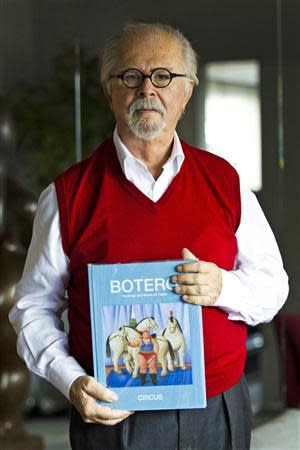Colombian artist Botero relives boyhood love of circus in new book
By Walker Simon NEW YORK (Reuters) - Colombian artist Fernando Botero showcases his enchantment with the circus, reliving the magic he felt as a boy during his first visit to the big top, in a new book "Circus: Paintings and Works on Paper." Botero, best known for his paintings of rotund people, includes in his book 137 paintings, 31 drawings and 22 watercolors done in 2007 and 2008, depicting a magical world where fantasy and reality are blurred. "The circus allows one to be logical and unreal at the same time," Botero, 81, said in an interview in New York. "In the circus all is possible, there can be a man with two heads, or a character with a green face." A lion cub smiles in self-satisfaction in one painting, an upright monkey wearing a green plaid suit holds a burning cigarette, looking reflective, in another work. In some, animals dwarf Botero's plump men and women, which have won him recognition as one of Latin America's most famous living artist. He attributes his appeal to his universal subjects. "The circus is a global theme," he said. "It exists in all parts of the world, maybe not in Africa, but it exists in Asia in all parts. In Latin America it's difficult to find a person who hasn't gone to the circus." Botero fell in love with the circus as a poor boy in Colombia, where going to the circus was an important event. "Everything seemed gigantic. There were some very big dogs ... they seemed like huge bears," he recalled. "The circus leaves a sweet memory." MUNDANE AND FANTASTIC But as an adult the big top lost its appeal until he saw a "poor, small circus" with just eight men and women performers about seven years ago in the Mexican beach resort of Zihuatanejo. "While I watched the show, I thought of the very big plastic (art) possibilities," he said. Botero also recalled the circus paintings of French artists Edgar Degas, Pierre-Auguste Renoir and Henri Matisse. The next day he visited the performers backstage and discovered they were nomads, a bit like himself. Botero, who is based in Pietrasanta, Italy, has studios and homes in New York, Colombia, Paris, Monaco and Greece. Some of his circus works blend the mundane and the fantastic, showing a woman hanging laundry, watched by an annoyed-looking camel with downturned lips. "All the animals I've painted always have a relationship with man," he said. "I have been told that part of the knowledge of the human anatomy comes from animals." Botero insists his bulky subjects are not fat, preferring to call them "volumetric." He traces his inspiration to 15th Century Italian Renaissance artists who pioneered techniques to display volume on flat canvases. But in a departure from his usual works, the book features a circus drawing and a painting, both called "Fat Woman." When asked about the unusual title for those works, he said, "Well, in the circus there are, for example, fat women. In the circus one sees the difference between the fat woman and volumetric woman, which I do." Since this summer Botero has found inspiration in the Kama Sutra, and has drawn 70 works in water colors, colored pencils and ink based on the ancient sex guide. "I haven't yet finished what I want to do," he said of the series, adding his workday usually goes from around 10 a.m. to until 8 p.m. When asked if he works less now than before, he said: "I work at the same rhythm, maybe today with more dedication, because the years go by, and one knows there is little time left to work." (Editing by Patricia Reaney and Jackie Frank)



